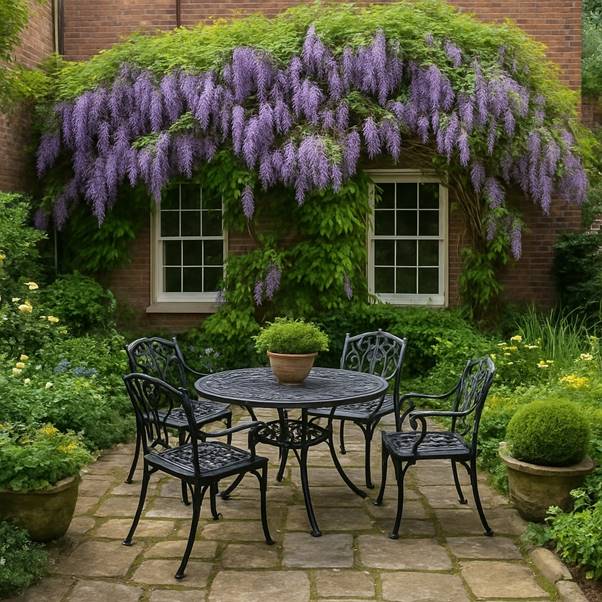
Start with the house—but don’t let it limit you
When it came to planning an outdoor entertaining space, Morrow had one rule: don’t let the house call all the shots. His Victorian home, charming from the front, is more of a plain brick box at the back. Instead of working around it, he worked with it—cloaking the rear wall in lush wisteria. The result? A green, living backdrop that softens the structure and sets a dramatic tone for the patio’s wrought-iron furniture and timeworn stone.
Design with structure—and freedom—in mind
Morrow loves change—especially in his planting schemes—but knew that too much variety could feel chaotic. So he laid down a solid foundation: stone, gravel, and a structured plant backbone that keeps the space grounded through every season, no matter how wild the perennials get.
Blur the boundaries
One of Morrow’s favorite small-space secrets? The disappearing fence trick. His garden is surrounded on three sides by 7-foot wooden fences. To visually erase them, he painted the wood in high-gloss black. It’s bold, but it works—clients are always skeptical until they see it in person. The shine makes the edges recede, letting the plants steal the spotlight.
Lose the lawn, gain the drama
Say goodbye to the grassy patch. “Lawns just don’t make sense in a compact urban garden,” says Morrow. Instead, he advocates for going big with beds full of lush perennials—or even sculptural topiaries. Less mowing, more wow.
The right tree matters
Removing three towering Magnolia grandiflora trees wasn’t easy, but it had to be done. “They were beautiful—just not right for the space,” Morrow admits. Their dense shade and bulk overwhelmed the garden. Only one, set far enough from the house, was spared and woven into the final layout.
Think decorative, not bulky
Once the structure was in place, Morrow curated the furnishings. His pick for small spaces: wrought iron. Its open, airy design keeps the garden feeling light, never cluttered.
Pots with personality
Containers are key in this garden. Morrow layers interest with seasonal plantings: single statement plants in smaller pots and bold mixes—think bananas, coleus, agaves—in larger ones. In winter, evergreen shrubs step in to keep the space alive and textured.
